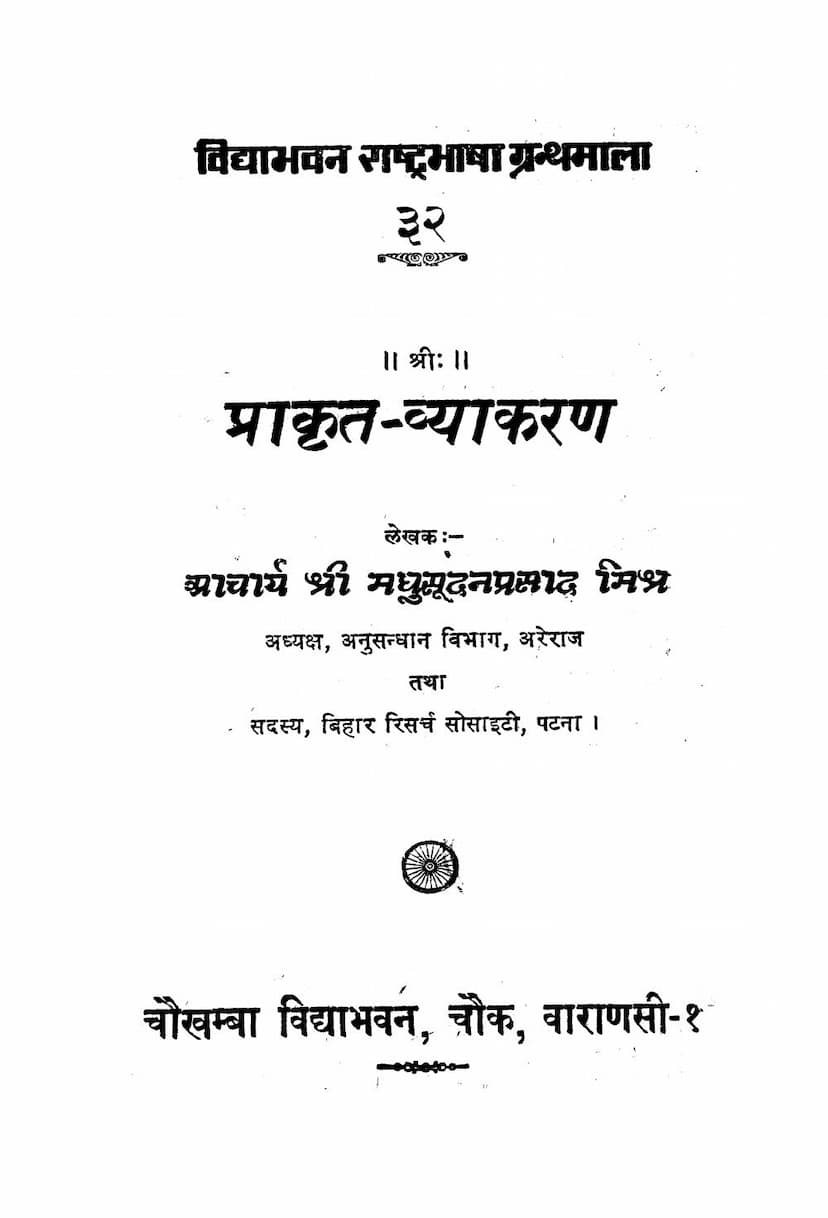Prakrit Vyakaran
Added to library: September 2, 2025

Summary
Here's a comprehensive summary of the Jain text "Prakrit Vyakaran" by Madhusudan Prasad Mishra, based on the provided pages:
The book "Prakrit Vyakaran" by Acharya Shrimad Madhusudan Prasad Mishra, published by Chaukhambha Vidyabhavan, Varanasi, is a detailed grammar of the Prakrit language. The preface highlights Prakrit as a more tender and sweet language compared to Sanskrit, drawing an analogy between the difference in grammatical structure and the difference between a man and a woman. It posits that language evolves through three stages: Sanskrit, Prakrit, and modern languages like Hindi, Marathi, Gujarati, and Bengali.
The book delves into the reasons for the evolution of languages, attributing it to the human tendency to avoid difficult pronunciations, which leads to gradual corruptions and the eventual formation of a dominant spoken language. The author illustrates this with examples like the transformation of "grammadhya" (middle of the village) into "gam mein" or "gaon mein" in colloquial speech, and "kumbhakara" (potter) into "kumbhar," "kuhar," and "kohar."
A significant portion of the early chapters discusses the origin of Prakrit. The prevailing view among Indian grammarians and rhetoricians is that Prakrit originated from Sanskrit, with the word "Prakrit" derived from "Prakriti" meaning nature, seed, or origin. Grammarians like Hemachandra, Vararuci, and Markandeya are cited, all asserting Sanskrit as the "Prakriti" or mother language. They define Prakrit as that which originates or emerges from Sanskrit.
In contrast, Western scholars like Pischel are presented, who propose that Prakrit was the language of the common people, and Sanskrit was its refined form. Pischel's argument, supported by other Western scholars, suggests that if Prakrit were derived solely from Sanskrit, all its words would be demonstrably traceable to Sanskrit, which is not always the case.
The text then explores the classification and dialects of Prakrit.
- Pali is acknowledged as an early form of Prakrit, used by Lord Buddha for his preachings, though it is now considered a distinct language due to subsequent differences.
- Maharashtri is identified as the superior and principal Prakrit dialect, as stated by Dandin in the "Kavyadarsha." Many grammarians have used the term "Prakrit" specifically to refer to Maharashtri. Famous works in Maharashtri include "Setu Bandha" (also known as "Ravana Vadha" or "Dashamukha Vadha") by Pravarasena, and "Gaha Sattasai" by Hala.
- The classification of Prakrit dialects varies among scholars:
- Vararuci identifies four main dialects: Maharashtri, Shauraseni, Magadhi, and Paishachi.
- Hemachandra expands this to seven, including these four along with Arsha, Chulika-Paishachi, and Apabhramsha.
- Trivikrama agrees with Hemachandra, excluding Arsha.
- Markandeya categorizes Prakrit into four major divisions: Bhasha, Vibhasha, Apabhramsha, and Paishach. He further elaborates on these, leading to sixteen sub-divisions. The text notes variations in the number of sub-divisions by other commentators on Markandeya.
- Dandin in "Kavyadarsha" classifies literature into four types: Sanskrit, Prakrit, Apabhramsha, and Mishra (mixed). He considers Maharashtri, Shauraseni, Gaudi, Lati, and Bhootbhasha (Paishachi) as Prakrit dialects.
The book details the usage of Prakrit dialects in Sanskrit drama:
- In dramas, aristocratic and educated men use Sanskrit, while noble and educated women use Shauraseni for prose and Maharashtri for poetry.
- Magadhi is spoken by lower-class characters and those of lower standing.
- Shauraseni is primarily a prose language, and Maharashtri is primarily a poetic language.
- Other dialects like Avantika, Dhakka, Shabari, Prachya, and Chandali are also mentioned, with some scholars classifying Avantika and Prachya under Shauraseni, and Dhakka, Shabari, and Chandali under Magadhi.
- "Mṛcchakatika" is highlighted for its diverse use of Prakrit dialects, including those not commonly found in other plays.
The text then proceeds to provide extensive grammatical rules for Prakrit, covering:
- Phonetics and Phonology: Discusses the alphabet, vowel and consonant changes, deletion of letters (luk), assimilation, and the use of anunasika (nasalization). It details specific rules for the modification of sounds based on their position in a word and their relation to other sounds.
- Sandhi (Vowel and Consonant Combination): Explains the rules governing how vowels and consonants combine or change when words are joined, noting that these rules are often optional in Prakrit.
- Noun Declension (Lingānushāsana): Details the gender and number of nouns, explaining the absence of the dual number and the replacement of the dative case (fourth declension) with the genitive case (sixth declension). It provides rules for the declension of masculine, feminine, and neuter nouns ending in various vowels and consonants, with specific attention to declensions in Maharashtri, Shauraseni, and Apabhramsha.
- Pronouns: Discusses the forms of demonstrative pronouns like "yad," "tad," "etad," and "idam" in Prakrit.
- Adverbs (Avyaya Prakaran): Explains the usage of various adverbs and interjections with their specific meanings and contexts.
- Verb Conjugation (Tinanta Vichara): Covers the conjugation of verbs in different tenses (present, past, future) and moods (imperative, potential), outlining the specific suffixes and changes that occur. It notes the absence of the distinction between the atmanepadi and parashmapadi conjugations for most roots, except for some exceptions.
- Specific Verb Forms: Details the unique formations of certain verbs like "bhū," "kṛ," "dā," "as," "smṛ," "dṛś," "vac," "bhid," "budh," "gam," "muc," and "chid" in different tenses and moods.
- Roots and their Transformations: Provides a comprehensive list of Sanskrit roots and their Prakrit equivalents, highlighting the significant phonetic and morphological changes. This section is particularly detailed, showcasing the transformation of many Sanskrit words into their Prakrit forms.
The book concludes with an index and a bibliography, listing the sources consulted, including other prominent Prakrit grammars and literary works. The overall aim of the book is to systematically present the structure and nuances of the Prakrit language, making it accessible to Hindi-speaking students of linguistics and literature.